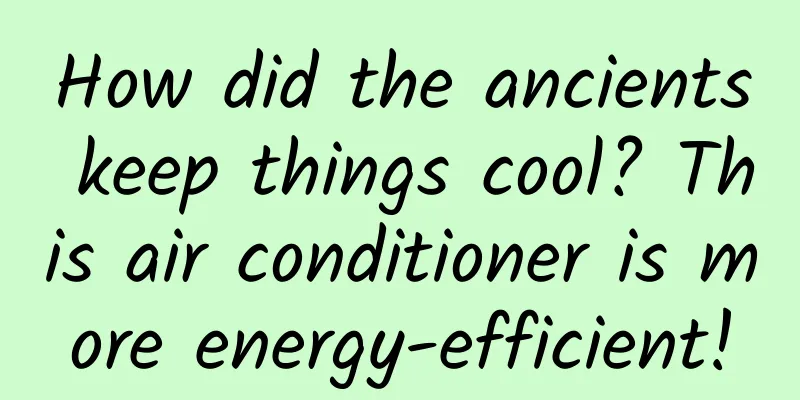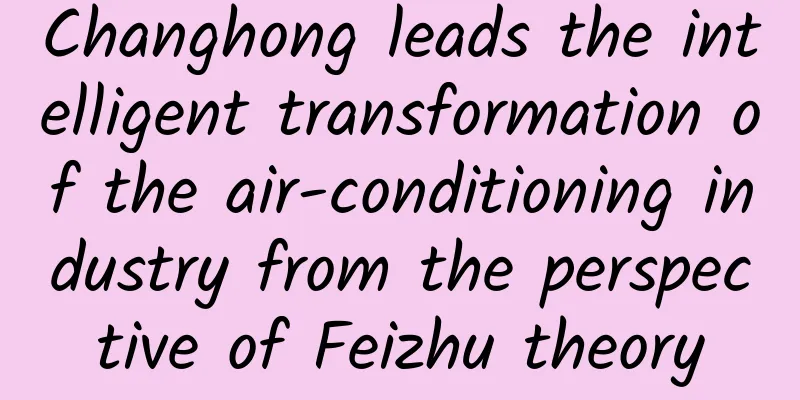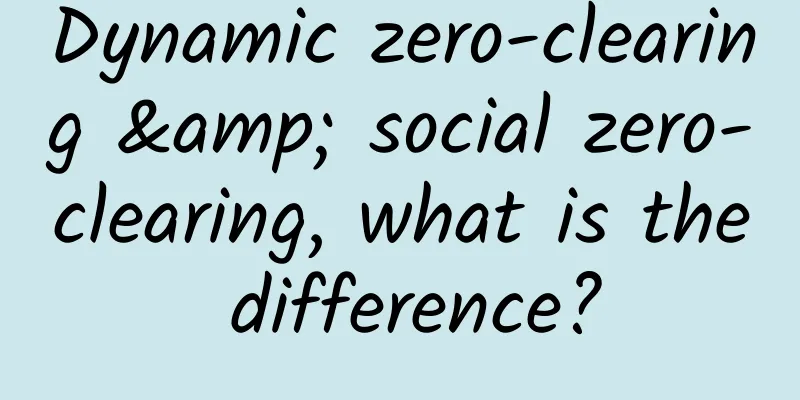How did the ancients keep things cool? This air conditioner is more energy-efficient!

|
Summer is here, and it is the season for barbecue and beer. We often see diners enjoying the air conditioning, drinking beer and feasting on food at roadside stalls. I don't know if you have observed that this kind of air-conditioning fan that blows out cool air is not the kind of air conditioner installed in our office or home. This kind of air-conditioning fan has the same principle as outdoor spray cooling and even the ancient "Zi Yu Pavilion" and "Hanliang Palace". They actually use evaporative cooling. Air conditioning fans, outdoor misting systems and rain shelters 1. What is evaporative cooling? Evaporative cooling is the process of cooling the air through the evaporation of water, which absorbs heat from the air and evaporates, thereby cooling the air. The drier the air is, the greater its ability to hold moisture. When water is sprayed on the air, the greater the degree of reduction in air temperature. If tap water or well water with a lower temperature is used, the air cooling effect will be better. Therefore, in a high temperature and dry environment, using an evaporative cooling air conditioning fan to cool the air consumes much less electricity than using an air conditioner, thus having a good energy-saving effect. However, the amount of moisture that the air can hold is limited (after reaching the limit, any further moisture will flow out of the air in the form of liquid water). Therefore, the low-temperature air temperature that can be produced by evaporative cooling is limited by this characteristic, and it is impossible to produce very low temperature air. 2. It turns out that the ancients used evaporative cooling Thousands of years ago, ancient Egypt and Persia used evaporative cooling in the form of rooftop wind shafts called “wind catchers” that would move air upwind and down the shaft into a fountain inside the building, which would deliver the cooled air into the room. Middle Eastern "wind catcher" with wind deflectors and indoor fountains (fresco from the 2nd century BC) There are also records of evaporative cooling air conditioning in ancient China. Ding Huan, an inventor in the Han Dynasty, invented the seven-wheel fan . "The seven-wheel fan has seven wheels connected, and the diameter of each wheel is one meter (Volume 1 of "Xijing Miscellaneous Records")". Later generations used hydraulic power to drive it and introduced water flow to the position of air flow, which not only provided power but also used evaporative cooling to lower the air temperature, making people feel "the cool and rustling sound, not silk or bamboo, but the sound of nature that can be heard from afar (Qianlong's "Forty Scenes of the Old Summer Palace")". Similar structures include Ziyu Pavilion and Hanliang Palace . As a poem goes, "The red amber lamp seems to be leaking rain, the crystal curtain is bright and ventilated (Liu Yuxi's "Summer Vacation at the Water Pavilion" from Liu Fu Ma)", cold water is transported to the top and then flows down from the eaves to form a water curtain, which has the effect of cooling down. Estimated including the principle of the Cool Palace, the Forty Scenes of the Old Summer Palace, Water and Trees, Mingse In ancient times, using the principle of evaporative cooling to escape the heat and keep cool in the summer was a service that only high-ranking officials could enjoy. Today, with the development of society, air conditioners and multi-split units that use electricity to drive refrigeration have entered the homes of ordinary people. However, evaporative cooling still plays an irreplaceable role. Evaporative cooling has transformed from a very simple ventilation and cooling method to an energy-saving and green technology that utilizes renewable energy such as dry air. It will effectively promote the realization of "carbon peak and carbon neutrality". 3. Green and energy-saving evaporative cooling technology In arid or semi-arid areas in the west, many industrial buildings use evaporative cooling air systems to completely replace mechanical refrigeration and air-conditioning systems. In humid and semi-humid areas, dew point evaporative cooling can also be used to achieve refrigeration, thereby improving the working environment of the workshop. In the era of big data, communication rooms and data centers operate non-stop throughout the year, and energy consumption continues to increase. However, the use of evaporative cooling technology in winter or transitional seasons, combined with indirect evaporative cooling pre-cooling in summer, can significantly reduce annual operating energy consumption. Evaporative cooling also plays an irreplaceable role in household air conditioning. In addition to the air-conditioning fans mentioned above, evaporative cooling can also be combined with new household air-conditioning technologies. In the Global Refrigeration Technology Innovation Award held in 2021, the Chinese team proposed an air-conditioning solution called "Advanced Vapor Compression Refrigeration Technology Integrating Evaporative Cooling and Solar Photovoltaics", which organically combined evaporative cooling, solar photovoltaics and high-efficiency refrigeration systems to achieve high-efficiency energy saving of air conditioners and precise control of indoor temperature and humidity, and stood out from more than 2,100 teams to win the championship. This technology uses evaporative cooling to use dry air as a means of regulating the indoor environment, combined with climate-adaptive ventilation control technology, to achieve ventilation, cooling, and dehumidification functions, opening up a new direction for the development of air-conditioning technology. Combining evaporative cooling, a technology with thousands of years of application history, with new technologies, we can tap into the application value and energy-saving potential of evaporative cooling, thereby contributing more wisdom, solutions and strength to global energy conservation, emission reduction and low-carbon transformation, and injecting strong momentum into green development. Global Cooling Technology Innovation Award Ceremony References: [1] Kheirabadi, Masoud (1991). Iranian cities: formation and development. Austin, TX: University of Texas Press. [2] Xu Aiqing. What are the secrets of ancient people to avoid summer heat? [J]. Science Grand View Garden, 2022, No.645(13):72-75. END Author: Yang Zixu, Postdoctoral Fellow, Department of Architectural Science, Tsinghua University Source: Beijing Refrigeration Society (some illustrations are from the Internet) |
Recommend
Why is the public relations of that video website so "capricious"?
Yes, when you see this title, you must think of t...
Decoding the power of Snapchat from my social product syllogism
Snapchat is finally going public. The company has...
The million-dollar Douyin traffic strategy
In the past three years, I have managed the entir...
Customer acquisition costs dropped by 50%! Short video marketing skills in the wedding industry!
With the continuous development of my country'...
Brazilian Automobile Dealers Association: In April 2024, sales of domestically produced cars in Brazil have soared 8 times to 48,000 units
According to recent news, sales of domestically p...
Down jackets can’t be machine washed, and they can’t be dry cleaned either?
Audit expert: Zhu Guangsi Member of Beijing Scien...
A tearful suggestion on advertising purchased with a budget of 1 million
Summary of advertising placement on 7 major chann...
There are 5 major health risks behind leg cramps! Huaxi doctors: It has nothing to do with height growth...
When I was a kid, I would occasionally get leg cr...
Official reminder! Be careful when eating this kind of rice noodles recently, as it may cause death!
Expert of this article: Fu Shufang, Master of Foo...
UPYUN launches CDN real-time performance monitoring
In 2014, entrepreneurs became the protagonists of...
Keep product operation analysis!
1. Demand Background 1.1 Review of Competitive Pr...
How to write a copy that takes advantage of New Year’s Day?
How to write a copy that leverages the situation?...
Double 11 sales guide! It’s easy to acquire users by advertising like this!
Double Eleven is coming soon! For advertisers, Do...
Coughing non-stop, use cough patch? Beware of chemical burns
Audit expert: Peng Guoqiu Deputy Chief Physician,...









